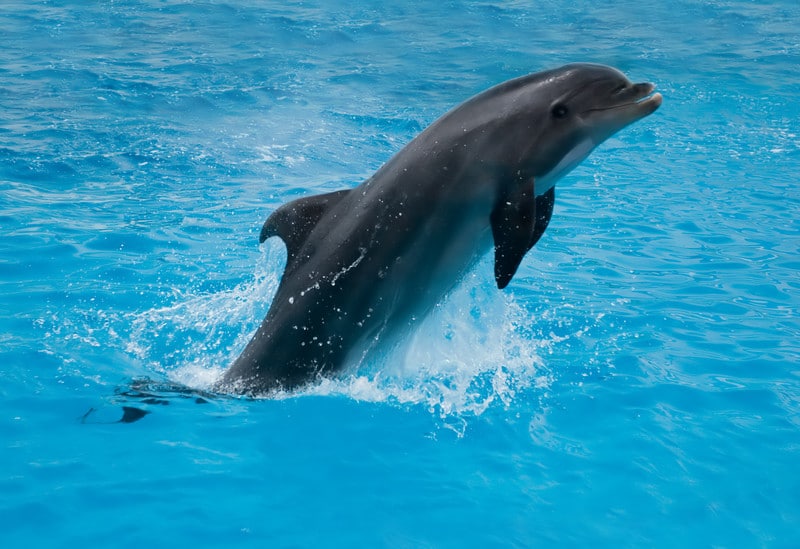Often described as an animal with a playful nature, the dolphin has been known to create underwater bubbles, play chase and jump out from the waves. In fact, the 1990’s film, Flipper, took these qualities and made it into a well-known production Some cultures even consider the dolphin to symbolize harmony, life and protection. But what exactly makes these marine mammals so extraordinary? And what are they able to find in the vast depths of the ocean?
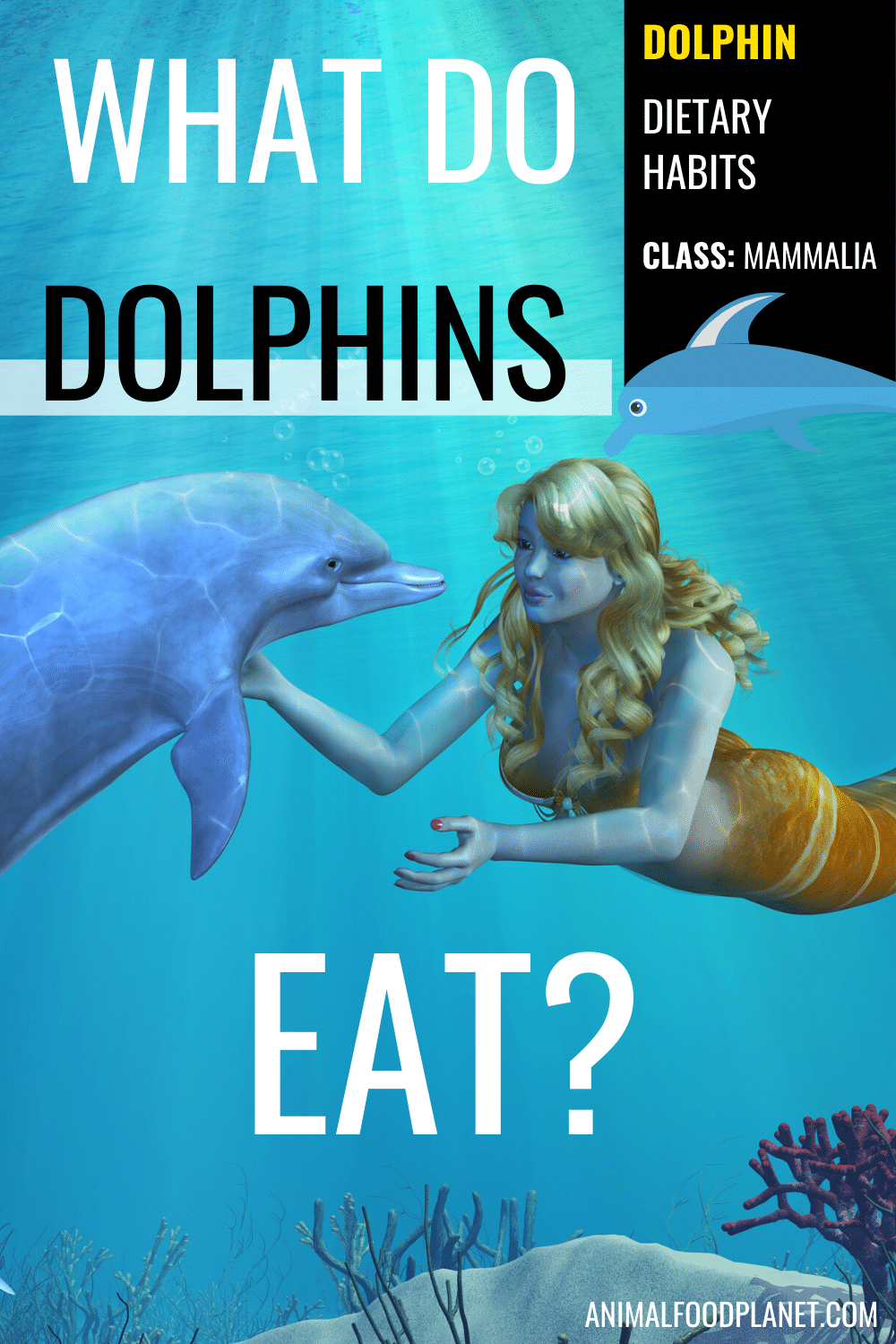
WHAT DO DOLPHINS EAT?
To pinpoint only a few meal preferences would be quite difficult as there are more than just one species of dolphins in existence. Across the board, all dolphins are carnivores, meaning that they strictly meat eaters. They are also termed with the name, opportunistic feeders due to the fact that they will eat a variety of available options. These food items include fish, squid, turtles, crustaceans and sometimes even marine mammals that reside on the land.
Dolphins are quite unique, especially when studying the different types. Some do not truly understand what the word “dolphin” entails.
DOLPHIN TAXONOMY
When talking about dolphins, most of the public will picture the iconic Common dolphin. These characteristics include a streamlined body, long slender nose, a blowhole, and flippers. But not all dolphins share these features.
Dolphins are found in the infraorder Cetacea, otherwise known as marine mammals. They then can be sorted into the parvorder Odontoceti that makes up the toothed whales.
There are 5 living families belonging to the dolphin and more than 40 species found nearly all over the world. Each individual shares those features that the Common dolphin has, yet there can be variations in size, shape, color, and length of bill.
The fascination of dolphins has existed for centuries. And although there are approximately 600,000 existing individuals, a small portion of dolphins are kept in captivity. Comparing the diet of the wild and captive-bred dolphins lets us know about their daily requirements.
WHAT DO DOLPHINS EAT IN THE WILD?
It is now known that 71 percent of the Earth’s surface is covered with water. Within all that liquid, there are four aquatic biomes, or habitat. This makes honing in on a few meal preferences difficult. In other words, to fully understand what dolphins eat in the wild, we must break them down into a few of the different species.
Common Bottlenose Dolphin
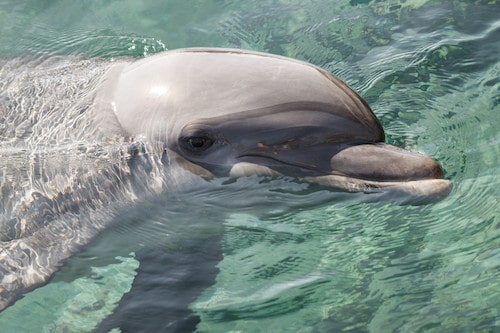
The Common Bottlenose Dolphin (Tursiops truncatus) is one of the better-known species of dolphin. They are found in the temperate and tropical waters of the Atlantic and the Pacific Ocean. Making up the largest species of dolphins with a beak, they possess gray bodies and weigh between 150 to 650 kilograms with a length of 2 and 4 meters. Their life span in the wild typically averages around 17 years.
This species of dolphin has a large range of meal items. Fish makes up the most commonly hunted prey, particularly the European hake (Merluccius merluccius) that swims in large schools. They also consume octopus, squid, shellfish, and crustaceans.
Amazon River Dolphin
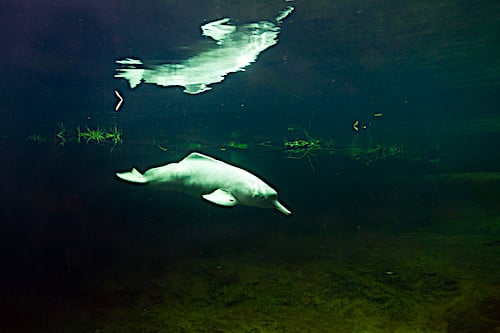
Also referred to as the “Boto” or “Pink river dolphin”, the Amazon river dolphin (Inia geoffrensis) is the biggest of its kind to live in freshwater habitats at around 185 kilograms. In fact, they do not come into contact with any of the existing oceans. Instead, they are found throughout the majority of the Amazon and parts of freshwater rivers found throughout South America. As the name suggests, they are a pale pink hue and have a much longer snout than other dolphins. They can live up to 30 years in the wild.
Given the habitats that they live in, you would assume that their diet might be more limited than that of a saltwater species. A surprising fact about these animals is that they can actually move between rivers, ponds, and lakes in the event of flooding. This vastly changes the available options.
Most river dolphin species have been found to be nearly blind due to the fact that they rarely use their sight in the muddy waters. The Pink river dolphin does not share this hindrance. With a better sense of sight, these individuals hunt a variety of fish, shrimp, and turtles. One such fish found in the Amazon River is the piranha, though it is no match for these dolphins. One adaptation that this dolphin species has is the ability to rotate their necks 180 degrees. This helps them navigate the windy rivers.
Short-finned Pilot Whale
Remember how broadly the term “dolphin” can be used? This is one of the misconceptions when considering which water dwellers are in fact dolphins. The Short-finned Pilot whale (Globicephala macrohynchus) is a true member of the oceanic dolphins. Their bodies are stockier with darker coloration and they lack the long beak that the other two dolphins have. Depending on gender, these animals weigh up to 3,200 kilograms and have a body length of around 5.5 meters. They also typically live up to 45 years of age.
These animals are found nearly all around the world in the salty oceanic habitats. They tend to prefer tropical waters due to the fact that they are warm and contain higher percentages of their coveted meal option, the squid. Short-finned pilot whales tend to have more in common with larger dolphin species, particularly in what they eat.
As mentioned earlier, these individuals definitely prefer to hunt squid. Thinking about their body size alone, it is logical for these animals to become satisfied with a few squids rather than copious amounts of fish. They tend to shift their preferences to herring, cuttlefish, and octopus when this type of food is not present.
Killer whale
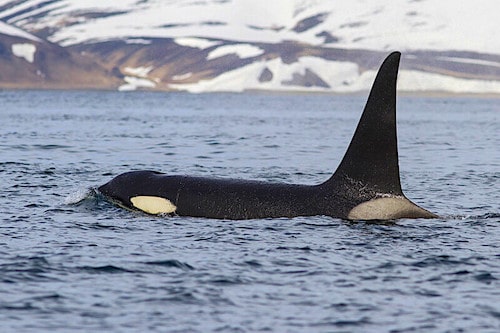
When talking about this type of aquatic mammal, it would be silly to not mention the largest dolphin in existence. The Killer whale (Orcinus orca) is, in fact, a toothed whale, which falls under the category of oceanic dolphins. They are widely known for their black bodies with white patches. They also do not have a long beak. These individuals weigh up to 10,000 kilograms and measure around 9 meters in length. On average, they will live around 30 to 50 years in the wild.
It is uncertain about their current worldwide population, but they do inhabit every ocean. Tourists travel to the west coast off of the United States and Canada to see these giants for they are more commonly found in the Arctic and Antarctic.
The Killer whale is considered to be an apex predator, meaning that they have no other animals that will compete with them. Because of this, they are able to have their pick of a meal. As for strictly aquatic species, this dolphin will prey upon squid, octopus, sharks, sea turtles, rays and various fish. They do not stop there, however. It is not rare to see a Killer whale jump out of the water to catch birds. As for other marine mammals, they consume penguins, seals, dugongs and sea lions.
By studying only a small handful of the current dolphin species, it is easy to see that there are quite a few differences in their diet. Meal preference isn’t the only changeable factor. These animals also differ in their hunting tactics.
HOW DO DOLPHINS HUNT IN THE WILD?
Due to the fact that dolphins live in separate biomes and have vastly different food available, they have needed to alter their hunting techniques. Sometimes they even use that playful nature as a way to catch their meals.
Fish whacking
With a streamlined body specifically designed for the water, some dolphin species can reach speeds of around 60 kilometers per hour. Fish, however, can evade a dolphin despite the high-speed chases. That is why some dolphins use a technique called fish whacking. This strategy involves a dolphin hitting a fish with its fluke or tail. The fish is then launched out of the water, making it stunned and thus allowing the dolphin to easily catch its prey.
Echolocation
The ocean is a near limitless body of water. In order to hunt for their prey, dolphins will use echolocation. Essentially, the individual uses high-frequency clicking sounds to send sound waves into the water. These sound waves then bounce off of nearby objects, telling the dolphin about the fish’s size, shape, and speed in which it is traveling. Interestingly, sound waves travel nearly five times faster than if produced in the air. This allows them to “see” their prey, even in such an expansive setting.
Prey herding
Most dolphins tend to live in groups that are referred to as pods. These groupings generally consist of 2 to 30 individuals at one time. In certain circumstances, pods can join together to create a group of over 1,000 members. With such numbers of individuals, they can successfully hunt a larger school of fish.
Prey herding at first looks like a solo sport. One member of the pod will swim in tight circles, all the while using its fluke to hit the water. As the fish become aggravated, they attempt to flee. Other dolphins in the pod then make their move by blocking the exits. With nowhere to go, the fish jump out of the water, creating a fun catching game for the dolphins involved.
Corralling
When comparing separate hunting strategies, corralling and prey herding look nearly identical. There is, however, one key difference. Just as before, one of the dolphins will swim in a circle to drive the fish in the other direction. This time, the tail of the dolphin hits the sandy floor, creating a “net” made of mud and silt. With the barrier in place, the fish then is pushed toward the other members of the pod. Devising such a tactic is quite unique in the animal kingdom.
Beaching
Not every way in which a dolphin hunts is all that easy. Some methods can be quite risky to the dolphin. Beaching, or “strand feeding” is another strategy that requires the use of a small pod. Working in unison, these aquatic animals will swim toward the shore at a higher velocity. This creates a wave that will push the fish onto the sand. The dolphins basically beach themselves in order to obtain these prey items.
One of the more obvious risks in strand feeding is that the dolphins are not always able to get back into the water. If they find themselves too far up on the shore, then they can find themselves helpless. Another threat is to their teeth. When a dolphin scoops up fish on the shore, they often find themselves ingesting sand. These pebbles, though small, wear down the teeth until they can no longer use them for eating.
To combat this problem, dolphins have learned to only beach themselves on one side each time they hunt. This way, they ensure that there is at least one side of teeth that remain sharp.
The dolphins most commonly seen using this tactic tend to live near more shallow waters. This includes the species belonging to river dolphins and bottlenose dolphins.
Dolphins kept in captivity do not use these hunting tactics because of two reasons, the first being that they are often contained in smaller enclosures. Secondly, captive-raised dolphins only eat a few different types of food.
WHAT DO DOLPHINS EAT IN CAPTIVITY?
There are a few species of dolphins that are more commonly seen in captivity, mostly for their ability to perform in shows. The three dolphin species found in enclosures around the world include the Bottlenose dolphin, Killer whale and the Beluga whale (Delphinapterus leucas).
Out of the three previously named common captive dolphins, the Bottlenose dolphin and the Killer whale are used specifically in tourist attractions. These animals are trained through positive reinforcement. In other words, they are fed a portion of their daily intake through treats. Generally, these dolphin species are either given sardines or a compacted gelatin with the necessary vitamins.
The Beluga whale is not all that common in shows, yet it does make an appearance in marine tanks for the public to learn from. In the wild, a Beluga would consume a plethora of bottom-dwelling animals such as octopus, squid, crabs, sandworms, crabs and various fishes. When placed into captivity, they are given the same gelatin substance that the other dolphins are fed. Some are even fed fish and squid to keep the animal satiated.
HOW MANY TEETH DOES A DOLPHIN HAVE?
You may have noticed earlier that the term “toothed whale” was mentioned. In general, every dolphin does have teeth, though this can range based on the given species.
The number of teeth located in the lower and upper jaws of a dolphin varies from one species to the next. For instance, the Short-beaked common dolphin (Delphinus dellphis) can have up to 240 teeth. The Bottlenose dolphin typically ranges between 80 and 100. Some species have as low as 2 teeth in their mouths.
All dolphins also share the same shape of teeth, regardless of how many they possess. These teeth are referred to as “conical” meaning that they are shaped in a cone-like fashion. This aids the dolphin in trapping, as they do not use their teeth to tear or chew. Surprisingly, dolphins swallow their prey whole.
DO DOLPHINS NEED TO DRINK WATER?
The majority of dolphin species live in salty ocean water, making it impossible for them to drink from their existing habitat. Dolphins are, after all, still mammals. This makes water essential. But how do you survive in a salt-riddled environment without becoming dehydrated?
One way in which dolphins obtain water is through the food that they eat. Squid and fish are among the prey that contains a large amount of water.
In addition, these animals don’t need to drink much water each day. With terrestrial mammals, like ourselves, we tend to sweat. This can cause dehydration if not properly taken care of. But in the water, a dolphin does not experience sweating, meaning that they don’t lose water that has been ingested.
But how do they swallow their food without taking in salt water?
When a dolphin opens its mouth to eat prey items, it also swallows a good amount of seawater. Dolphins have gotten around this due to their advanced filtration system. By separating the salt from the water that they consume, they avoid the risk of ruining their internal organs.
HOW DO DOLPHINS DIGEST FOOD ON THE GO?
For an animal living on land, stopping to digest one’s food is necessary. In the water, however, that luxury is lost. Dolphins, like other aquatic animals, need to keep moving in order to survive. This is especially important since they need to surface for air every 7 minutes. The same goes for digesting their food.
Most dolphins have a stomach with three separate chambers, each responsible for a different stage of digestion. Once the food has been swallowed whole, it travels down to the forestomach where it is either saved for later or regurgitated. The next part, the fundic stomach, is responsible for breaking down the prey item. Lastly, the food is passed on to the pyloric stomach where the food is further broken down until eventually absorbed into the body.
HOW OFTEN AND HOW MUCH DO DOLPHINS NEED TO EAT?
Being opportunistic feeders, dolphins rarely refuse a meal. In fact, the majority of their day is spent hunting and eating. Even during the evening, these animals can be found feeding on fish or squid.
As for how much a dolphin eats in a day, it depends on the size and species of the animal. The Bottlenose dolphins have to consume approximately 4 to 6 percent of their entire body weight in food each day. This usually equals about 25 kilograms in a day’s worth. The reason for such quantities is due in large part to their high metabolism. If a dolphin did not hunt so often, they would fail to thrive.
RELATED QUESTIONS
Do dolphins eat penguins?
Most dolphins are incapable of consuming a penguin. The largest species of dolphin, famously known as the Killer whale will attack these larger birds when available. When a penguin enters the water, it is at risk of being consumed for this is when a Killer whale has the upper hand.
Do dolphins kill sharks?
You may have heard stories about divers and sharks where a dolphin will come along and protect the humans from potential bites. There are multiple accounts of this happening. Some are able to kill a shark through repeatedly ramming it with their beak, but they mostly simply drive them off.
Can a dolphin bite?
Now knowing the number of teeth inside a dolphin’s mouth may answer this question altogether. As with any animal, there is the possibility of a bite. Dolphins are known to be quite friendly, even to strangers. They will only become nippy when agitated or angry. If you come across a pod of dolphins, it is best to leave them alone.
What animals eat dolphins?
Aside from the Killer whale, most dolphins need to steer clear of larger sharks as they oftentimes attack younger individuals. Tiger, Dusky, and Great white sharks are the most likely to kill and eat a dolphin. An additional predator is a human population. Dolphins can be hunted for their meat or accidentally hurt by fishing nets.
How intelligent are dolphins?
Scientists have long studied and compared the intelligence of dolphins to humans. Their findings revealed that these creatures are far more understanding than we would first assume. Through various tests, dolphins have demonstrated self-awareness, problem-solving, emotions, synchronized communication and mimicry that is almost parallel to ours. Self-awareness, in particular, has only been found in humans and chimpanzees thus far, making the dolphin extremely intelligent.
The dolphin is a unique creature that has been represented as protective, playful and intelligent. Using these traits, these toothed whales formulate hunting tactics to ensure a hefty meal. With such strategy and coercion, it’s no doubt that the dolphin is a widely understated sea habitant.

